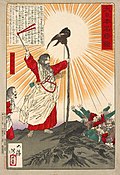Emperor Jimmu
Emperor Jimmu (神武天皇, Jinmu-tennō) was the 1st emperor of Japan,[1] according to the traditional order of succession.[2] Jimmu is known as the founder of the Imperial dynasty.
| Jimmu | |
|---|---|
| Emperor of Japan | |
 | |
| legendary | |
| Successor | Suizei |
| Born | legendary |
| Died | legendary |
| Burial | Unebi-yama no ushitora no sumi no misasagi (Nara) |
There are no certain dates for this emperor's life or reign.[3] The names and sequence of the early emperors were not confirmed as "traditional" until the reign of Emperor Kammu, who was the 50th monarch of the Yamato dynasty.[4]
Historians debate whether or not Emperor Jimmu actually existed because there is limited evidence of him. Some stories about him may reflect actual events that happened.
Traditional history
Jimmu is almost certainly a legend.[5] His name and genealogy are recorded in the Kojiki and Nihonshoki. Jimmu is regarded as a direct descendant of the Shinto sun goddess, Amaterasu.
During reign of Emperor Jimmu, the capital of Japan was at Kashiwabara, Yamato at the foot of Mt. Unebi.[6]
Events of Jimmu's life
The absence of information about Jimmu does not mean that he did or did not exist.[7] There is very little data about the rulers of Japan before the reign of Emperor Bidatsu[8]
The traditional story is that Jimmu came from Kyushu to Yamato Province on the island of Honshu. The story explains that he followed a three legged crow. He established his reign at Kashihara near Osaka.[7]

After his death
This emperor's official name after his death (his posthumous name) was regularized many centuries after the lifetime which was ascribed to Jimmu.[9]
The actual site of his grave is not known. According to the Imperial Household Agency, the emperor is venerated at a memorial Shinto shrine (misasagi) in Kashihara at Nara.[1] The mausoleum is located a short distance from Kashihara Shrine.
National holiday
In 1872, the Meiji government declared that February 11, 660 BC was the exact date on which the reign of Jimmu began. This was identified as the start of the Japanese nation. This mythical date was commemorated as the holiday Kigensetsu ("Era Day"). This national holiday was celebrated from 1872 to 1948.[10]
The Kigensetsu events in 1940 were special. They celebrated what was believed to be 2,600 years since the start of Emperor Jimmu's reign.[11]
There has been a similar Japanese national holiday since February 11, 1966. It is called National Foundation Day (Kenkoku Kinen no hi).[10]
Family tree
‡ not in the Nihon Shoki
Emperor Jimmu Media
Emperor Jimmu, ukiyo-e by Tsukioka Yoshitoshi (1880)
Depiction of a bearded Jimmu with his bow and the golden kite. This 19th-century artwork was painted by Tsukioka Yoshitoshi.
Unebi Goryō, the mausoleum of Emperor Jimmu in Kashihara City, Nara Prefecture
The inner prayer hall of Kashihara Shrine in Kashihara, Nara, the principal shrine devoted to Jimmu
Related pages
References
- ↑ 1.0 1.1 Imperial Household Agency (Kunaichō), 神武天皇 (1); retrieved 2011-10-19.
- ↑ Titsingh, Isaac. (1834). des empereurs du Japon, pp. 1-3; Brown, Delmer M. (1979). Gukanshō, p. 249; Varley, H. Paul. (1980). Jinnō Shōtōki, pp. 84-88.
- ↑ Ponsonby-Fane, Richard. (1959). The Imperial House of Japan, p. 29.
- ↑ Aston, William George. (1896). Nihongi, p. 109 n1.
- ↑ Kelly, Charles F. "Kofun Culture," Japanese Archaeology. April 27, 2009; retrieved 2011-10-19.
- ↑ Ponsonby-Fane, Richard. (1915). The Imperial Family of Japan, p. 1.
- ↑ 7.0 7.1 Nussbaum, Louis-Frédéric. (2002). "Jimmu Tennō," Japan encyclopedia, pp. 420-421; excerpt, "... it is not certain that he actually existed. He was probably a composite ...."
- ↑ Louis-Frédéric, "Traditional order of Tennō" at pp. 962-963; excerpt, "dates ... should be treated with caution up to Emperor Bidatsu Tennō, the thirtieth on the list."
- ↑ Brinkley, Frank. (1915). A History of the Japanese People from the Earliest Times to the end of the Meiji Era, p. 21; excerpt, "Posthumous names for the earthly Mikados were invented in the reign of Emperor Kammu (782–805) ...."
- ↑ 10.0 10.1 Nussbaum, "Kigen" at p. 514[dead link].
- ↑ Brownlee, John. Japanese Historians and the National Myths, 1600-1945: The Age of the Gods, pp. 136, 180-185.
Other websites
![]() Media related to Emperor Jimmu at Wikimedia Commons
Media related to Emperor Jimmu at Wikimedia Commons
| Preceded by –– |
Legendary Emperor of Japan Jimmu 660-585 BC (traditional dates) |
Succeeded by Emperor Suizei |








